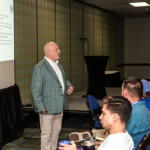Industry Advice Ask Mike: What’s the Value of Attending Trade Shows and Industry Education?
with Mike Anderson
This month, we “ASK MIKE” to share some of his personal experiences and perspectives on the value of trade shows and industry education. We at Hammer & Dolly hope you find the following exchange useful, and we encourage you to reach out to us if you have a question for Mike on this or any industry-related matter that he can answer in a future issue.
 Hammer & Dolly: We’ve talked a lot over the years about the value of trade shows and automotive industry education, and you’ve spent your career heavily involved in both. With SEMA 2024 right around the corner, let’s talk about why attending shows and seminars is still so important to you. How did you get your start with these things? What keeps you coming back?
Hammer & Dolly: We’ve talked a lot over the years about the value of trade shows and automotive industry education, and you’ve spent your career heavily involved in both. With SEMA 2024 right around the corner, let’s talk about why attending shows and seminars is still so important to you. How did you get your start with these things? What keeps you coming back?
Mike Anderson: NACE was the first trade show I ever went to back in the day. Once I went, I caught the fever. I walked the aisles and saw things I had never seen before. It was very eye-opening and educational. The show had the latest and greatest in equipment, management systems – you name it.
Closer to home, the first seminar I ever went to was through Mark Canby of Canby Motors, who was a WMABA member way back when. I went to his seminar and thought, ‘Man, this is the smartest guy in the world!’ I felt like he was saying everything I was thinking, and I could relate to what he was doing. I networked with some of the other people in the class and learned they were having the same challenges that I was having at the time. I found kindred spirits. My first seminar and my first trade show were different experiences, but they both created a fire and passion within me. I realized there were other people out there who thought the same way I did.
If you go to an amusement park, there’s something there for everyone – all ages, all everything. It’s the same thing when you go to SEMA. You have the Collision Industry Conference [CIC], the awards banquet, the Society of Collision Repair Specialists’ [SCRS] training sessions and National Auto Body Council [NABC] events, just to name a few things. There are all these other activities held in conjunction with SEMA. Being there always gives you a chance to connect with people from across the country. There’s always value in meeting up with vendors and seeing what’s new, but there’s also value in learning what other shops and members in the industry in other markets are doing. Going to SEMA and other shows and following their educational tracks is invaluable. SCRS does a great job of mixing it up at SEMA – it’s not just the same presenters every year. There are always new, up-and-coming speakers participating there.
H&D: One thing we’ve noticed over the past couple of years is the high number of first-time attendees at many of these shows. It seems that the newer people in this industry really embrace trade shows and seminars.
MA: Absolutely. Just today, I got a text from a younger member of our industry – whose family has already been in the business for two generations – who said, ‘Hi, Mike. I’m starting to research the SEMA Show. I saw that you followed SEMA on Facebook. I was just wondering if you’ve been there or know somebody who has.’ He’s in his twenties, has never been to SEMA before and wants to know what’s going on. That literally happened this afternoon.
H&D: That’s fantastic! Of course, we don’t want to leave out the fact that WMABA produces great educational content locally.
MA: WMABA was one of the first associations of its kind, and it was also one of the first to have a publication like Hammer & Dolly. I’ve always loved the magazine because it talks about the national stuff in addition to things happening in my area. Back then, we didn’t have social media – or even the internet. When I was in my late twenties or early thirties, WMABA and Hammer & Dolly were where I went to find out what was going on.
Obviously, past WMABA leaders like Sheila Loftus, Jerry Dalton, Les Pomeroy and Hans Martinsen were going to CIC on the national level and bringing that information back to us. That really helped me to stay current with what mattered to my business. It was my lifeline.
H&D: When you look back on your years as a shop owner, what was the biggest thing you took away from a trade show that helped your business that you wouldn’t have learned any other way?
MA: I taught myself how to write an estimate. I would read the Mitchell manual and learn about not-included items and ask for them. But at the earliest trade shows I attended, I learned about even more not-included items. I realized I didn’t fully understand some of the things I had been reading on my own, and being at those shows taught me how to make more money through estimating. I also took advantage of classes on blueprinting and leadership back then. My quest for knowledge continues to this day, and that knowledge only comes by attending trade shows and seminars.
Want more? Check out the October 2024 issue of Hammer & Dolly!
